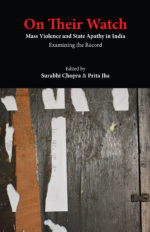Surabhi Chopra is co-editor of ON THEIR WATCH: Mass Violence and State Apathy in India. Examining the Record. She is an Assistant Professor at the Faculty of Law, Chinese University of Hong Kong. She researches transitional justice, national security and the rights of the poor. She replies to four questions we posed before her.
1. How did you get involved in this project? What made you do it?
Harsh Mander initiated the project that led to On Their Watch. Harsh had been involved in the movement for the right to information. He had also been deeply involved in a grassroots movement for justice in Gujarat after 2002, called Nyayagraha. Nyayagraha activists were using the Right to Information Act in their work, and Harsh was keen to use this law on a larger scale in relation to communal violence.
I had been using the RTI Act in my own work as a human rights lawyer. Seeking official information about preventing torture had led to some interesting discoveries, and I felt that the RTI Act could be used much more in documenting grave abuses of human rights and responding to them. So I was drawn to a project that would use the right to information for learning more about some of the most serious episodes of violence that India has seen.
The International Development Research Centre, and Navsharan Singh in particular, supported the research. A small team of people got involved in the project. Some, like Prita Jha, Suroor Mander and Anubha Rastogi, had experience in law and human rights. Rekha Koli had worked on using the RTI Act on a range of issues, and coordinated the rather sprawling right to information endeavor we launched. We sought official records on mass violence in Nellie in 1983, Delhi in 1984, Bhagalpur in 1989 and Gujarat in 2002.
2. The book is being seen as an example of what a dogged pursuit of RTI and the intelligent analysis of the information can achieve. However, we know there have been attempts to restrict the scope and dilute the content of RTI, even undermine it altogether. A decade’s experience shows mixed results. How does one work for a regime of transparency amidst increasing corporatist control of state policies and key institutions?
The RTI Act had been in force for about four and a half years when we began using it. We found that public authorities varied greatly in their comfort with this new law. The army seemed inexperienced, and frankly hostile, when responding (or not) to applications. The Ministry of Home Affairs seemed to routinely deflect applications by transferring them to several different departments. The police, on the whole, were reasonably responsive – the RTI Act was something they clearly dealt with routinely. However, we found that most police stations lacked capacity and misunderstood the Act – they viewed provisions that were clearly permissive as restricting information.
You’ve mentioned creeping restrictions and changes to the RTI Act. These incremental restrictions don’t surprise me. The Act attempted a 180-degree reversal of an entrenched “official secrets” culture. Many state governments have resisted the RTI Act from early on by creating cumbersome procedures that discourage people from applying for information. More recently, as you point out, the Act is in danger of being substantively whittled down.
Such incremental undermining has been debated opposed by right to information advocates. But I think those of us who don’t work primarily on RTI need to stay engaged and need to keep using the Act as much as possible. The RTI Act is such an important tool for accountability, for all of the problems in implementing this law (People’s Monitoring of the RTI Regime in India, is a comprehensive recent review). Other accountability mechanisms such as quasi-autonomous commissions and public interest litigation may have many strengths, but are fundamentally top-down and elite-driven. In comparison, the right to information is far more profoundly democratic and has the potential to be very egalitarian. Anyone, even groups who have been attacked on the State’s watch, can seek information important to them through this law. So I think even those of us who are not RTI-specialists need to use the Act as much as possible, and become more skilled and strategic at it. Hopefully, this will generate government practice and legal decisions that, in the round, make the State more transparent.
3. The book focusses on mass violence – what does this term mean, and why use this particular term? There is a risk it erases the planning, coordination and State tolerance involved in perpetrating the type of violence the book discusses.
This book looks at violence where the victims were targeted because they were known or were presumed to belong to a particular religious community. This sort of violence is commonly described as communal violence or as a riot. We definitely rejected the word ‘riot’, as it tends to suggest a more or less spontaneous, and a more or less equally matched, clash between two groups. This term erases the role of the State in enabling such violence to occur, and the role of political groups in inciting the violence and manufacturing tension between religious communities – what Paul Brass has described as “institutionalized riot system”.
We were looking at episodes of violence that were relatively concentrated in space and time, where a large number of people were violently attacked and killed, injured, displaced from their homes, suffered financial loss, and were reduced to living in fear. We struggled with what the appropriate description might be. The feminist movement has taught us that words have power, that naming is political – the terms we use can recognize violence or trivialize and ignore it.
We didn’t want to use the term “targeted violence” because all deliberate violence – from murder to snatching a bag – is targeted. The violence we discussed encompassed many distinct hate crimes, but a hate crime can be against an individual by an individual, without the State playing a facilitative, permissive role. We were focusing specifically on widespread, systematic violence. A part of our argument is that such widespread, fierce violence simply cannot occur unless the State is apathetic, and through inaction, supports the direct perpetrators. As you point out, the term ‘mass violence’ might invoke too much the people directly, physically involved in violence. So I’m not sure the term is entirely successful. However, we do need to keep grappling with these semantics and develop appropriate, easily-usable descriptors, even if this seems like a point of detail when thinking about such terrible events, so that we can shift the default vocabulary of the popular media, of everyday conversation. A semantic shift is a part of acknowledging that such violence is planned, directed, primarily one-sided, and the State has failed to step in.
4. Your study shows the extent to which law and order machinery, bureaucracy, judiciary and media are implicated to varying degrees in the production of communal violence and the consolidation of the power of the Hindu Right, which is reaching frightening proportions. What are the prospects of justice and peace in the present? What would be your personal take on this?
I feel unqualified to respond to this, to be honest, since I am not a grassroots, human rights defender. Of course, it was terribly disheartening to watch the Modi-led BJP win a Parliamentary majority (albeit with less than a third of absolute vote-share). I think in these next few years, religious minorities in India are going to be vulnerable. Well-known secular activists are likely to be vulnerable, as are lesser-known activists such as the people who volunteer with Nyayagraha. And I think this includes not just specific, direct harassment, but also something more diffuse – what Navsharan Singh discusses as a landscape or culture of impunity – which includes the abusive trolling that follows any media article that is even mildly critical of the current regime, it includes major news channels downplaying recent violence in Trilokpuri, and also includes avowedly liberal public intellectuals politely minimizing what happened in 2002.
That said, though the Hindu-Right is in power at the Centre and in several states, it won the national elections with a vote-share of only 31 percent. Many young voters – who seem to have supported the BJP in greater proportion than older voters – were young children in 2002, and may not recall the terrible images, the photos and the television footage, from massacres in Gujarat at the time. We have to hope that the narrow notion of development that fuelled their support for Modi can evolve into a more humane, egalitarian idea of a good society, and a more accurate sense of history.
When thinking about how to react, my response is the same on this question as on the earlier question about the right to information. I think it’s important to stay engaged and keep pressing for equality, freedom from persecution, accountability, regardless of whether we are well-established and seasoned, or just starting out. We can contribute in any number of capacities, simply as concerned individuals, or in our professional capacities as journalists, litigators, artists, researchers, doctors, teachers, publishers. Three Essays is publishing work that many large publishing houses would probably not welcome at present, and that is very valuable. This book, we hope, makes it a little more difficult to deny that impunity for mass violence results from choices the State has made, since our research echoes and builds on civil society findings by drawing on the State’s own records.


